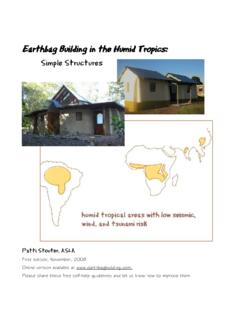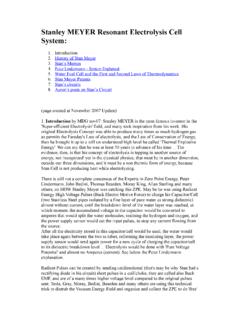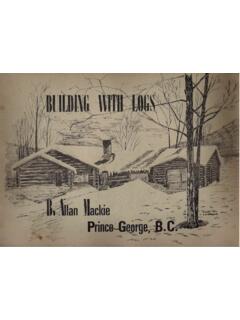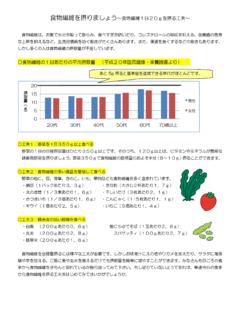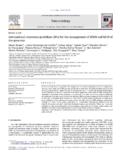Transcription of THE NATURAL WAY OF FARMING - Rivendell Village
1 THE NATURAL WAY OF FARMING The Theory and Practice of Green Philosophy MASANOBU fukuoka Preface NATURAL FARMING is based on a nature free of human meddling and intervention. It strives to restore nature from the destruction wrought by human knowledge and action, and to resurrect a humanity divorced from God. While still a youth, a certain turn of events set me out on the proud and lonely road back to nature. With sadness, though, I learned that one person cannot live alone. One either lives in association with people or in communion with nature. I found also, to my despair, that people were no longer truly human, and nature no longer truly NATURAL . The noble road that rises above the world of relativity was too steep for me. These writings are the record of one farmer who for fifty years has wandered about in search of nature.
2 I have traveled a long way, yet as night falls there remains still a long way to go. Of course, in a sense, NATURAL FARMING will never be perfected. It will not see general application in its true form, and will serve only as a brake to slow the mad onslaught of scientific agriculture. Ever since I began proposing a way of FARMING in step with nature, I have sought to demonstrate the validity of five major principles: no tillage, no fertilizer, no pesticides, no weeding, and no pruning. During the many years that have elapsed since, I have never once doubted the possibilities of a NATURAL way of FARMING that renounces alt human knowledge and intervention. To the scientist convinced that nature can be understood and used through the human intellect and action, NATURAL FARMING is a special case and has no universality.
3 Yet these basic principles apply everywhere. The trees and grasses release seeds that fall to the ground, there to germinate and grow into new plants. The seeds sown by nature are not so weak as to grow only in plowed fields. Plants have always grown by direct seeding, without tillage. The soil in the fields is worked by small animals and roots, and enriched by green manure plants. Only over the last fifty years or so have chemical fertilizers become thought of as indispensable. True, the ancient practice of using manure and compost does help speed crop growth, but this also depletes the land from which the organic material in the compost is taken. Even organic FARMING , which everyone is making such a big fuss over lately, is just another type of scientific FARMING .
4 A lot of trouble is taken to move organic materials first Here then there, to process and treat. But any gains to be had from all this activity are local and temporal gains. In fact, when examined from a broader perspective, many such efforts to protect the NATURAL ecology are actually destructive. Although a thousand diseases attack plants in the fields and forests, nature strikes a balance; there never was any need for pesticides. Man grew confused when he identified these diseases as insect damage; he created with his own hands the need for labor and toil. Man tries also to control weeds, but nature does not arbitrarily call one plant a weed and try to eradicate it. Nor does a fruit tree always grow more vigorously and bear more fruit when pruned.
5 A tree grows best in its NATURAL habit; the branches do not tangle, sunlight falls on every leaf, and the tree bears fully each year, not only in alternate years. Many people are worried today over the drying out of arable lands and the loss of vegetation throughout the world, but there is no doubting that human civilization and the misguided methods of crop cultivation that arose from man s arrogance are largely responsible for this global plight. Overgrazing by large animal herds kept by nomadic peoples has reduced the variety of vegetation, denuding the land. Agricultural societies too, with the shift to modern agriculture and its heavy reliance on petroleum-based chemicals, have had to confront the problem of rapid debilitation of the land.
6 Once we accept that nature has been harmed by human knowledge and action, and renounce these instruments of chaos and destruction, nature will recover its ability to nurture all forms of life. In a sense, my path to NATURAL FARMING is a first step toward the restoration of nature. That NATURAL FARMING has yet to gain wide acceptance shows just how mortally nature has been afflicted by man s tampering and the extent to which the human spirit has been ravaged and ruined. All of which makes the mission of NATURAL FARMING that much more critical. I have begun thinking that the NATURAL FARMING experience may be of some help, however small, in revegetating the world and stabilizing food supply. Although some will call the idea outlandish, I propose that the seeds of certain plants be sown over the deserts in clay pellets to help green these barren lands.
7 These pellets can be prepared by first mixing the seeds of green manure trees such as black wattle that grow in areas with an annual rainfall of less than 2 inches, and the seeds of clover, alfalfa, bur clover, and other types of green manure, with grain and vegetable seeds. The mixture of seeds is coated first with a layer of soil, then one of clay, to form microbe-containing clay pellets. These finished pellets could then be scattered by hand over the deserts and savannahs. Once scattered, the seeds within the hard clay pellets will not sprout until rain has fallen and conditions are just right for germination. Nor will they be eaten by mice and birds. A year later, several of the plants will survive, giving a clue as to what is suited to the climate and land.
8 In certain countries to the south, there are reported to be plants that grow on rocks and trees that store water. Anything will do, as long as we get the deserts blanketed rapidly with a green cover of grass. This will bring back the rains. While standing in an American desert, I suddenly realized that rain does not fall from the heavens; it issues forth from the ground. Deserts do not form because there is no rain; rather, rain ceases to fall because the vegetation has disappeared. Building a dam in the desert is an attempt to treat the symptoms of the disease, but is not a strategy for increasing rainfall. First we have to learn how to restore the ancient forests. But we do not have time to launch a scientific study to determine why the deserts are spreading in the first place.
9 Even were we to try, we would find that no matter how far back into the past we go in search of causes, these causes are preceded by other causes in an endless chain of interwoven events and factors that is beyond man s powers of comprehension. Suppose that man were able in this way to learn which plant had been the first to die off in a land turned to desert. He would still not know enough to decide whether to begin by planting the first type of vegetation to disappear or the last to survive. The reason is simple: in nature, there is no cause and effect. Science rarely looks to microorganisms for an understanding of large causal relationships. True, the perishing of vegetation may have triggered a drought, but the plants may have died as a result of the action of some microorganism.
10 However, botanists are not to be bothered with microorganisms as these lie outside their field of interest. We ve gathered together such a diverse collection of specialists that we ve lost sight of both the starting line and the finish line. That is why I believe that the only effective approach we can take to revegetating barren land is to leave things largely up to nature. One gram of soil on my farm contains about 100 million nitrogen-fixing bacteria and other soil-enriching microbes. I feel that soil containing seeds and these microorganisms could be the spark that restores the deserts. I have created, together with the insects in my fields, a new strain of rice I call Happy Hill. This is a hardy strain with the blood of wild variants in it, yet it is also one of the highest yielding strains of rice in the world.
